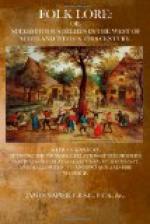From the death till the funeral it was customary for neighbours to call and see the corpse, and should any one see it and not touch it, that person would be haunted for several nights with fearful dreams. I have seen young children and even infants made to touch the face of the corpse, notwithstanding their terror and screams. If a child who had seen the corpse, but had not been compelled to touch it, had shortly afterwards awakened from a sleep crying, it would have been considered that its crying was caused by its having seen the ghost of the dead person.
If, when the funeral left the house, the company should go in a scattered, straggling manner, this was an omen that before long another funeral would leave the same house. If the company walked away quickly, it was also a bad omen. It was believed that the spirit of the last person buried in any graveyard had to keep watch lest any suicide or unbaptized child should be buried in the consecrated ground, so that, when two burials took place on the same day, there was a striving to be first at the churchyard. In some parts of the Highlands this superstition led to many unseemly scenes when funerals occurred on the same day.
Those attending the funeral who were not near neighbours or relations were given a quantity of bread and cakes to take home with them, but relations and near neighbours returned to the house, where their wives were collected, and were liberally treated to both meat and drink. This was termed the dredgy or dirgy, and to be present at this was considered a mark of respect to the departed. This custom may be the remnant of an ancient practice—in some sort a superstition—which existed in Greece, where the friends of the deceased, after the funeral, held a banquet, the fragments of which were afterwards carried to the tomb. Upon the death of a wealthy person, when the funeral had left the house, sums of money were divided among the poor. In Catholic




